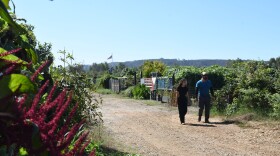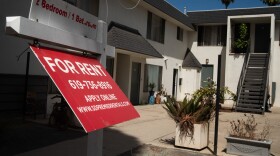The Southern California fall fire season has arrived with controversy. San Diego Gas and Electric is proposing to turn off power to the backcountry during high risk fire days. It’s a plan San Diego County fiercely opposes. State regulators could decide the matter this week.
On a quiet hill surrounded by brush on the west side of Ramona, Kit Kessinger stands next to the large steel frame of a house. He and his wife had been planning to build here for a while but the plans took on more urgency when their rental home burned down in the 2007 Witch Creek fire.
“And the only thing left standing was an ironing board,” he said.
Kessinger doesn’t plan to let a fire destroy his home again. He’s making this house as fireproof as he can, building it out of steel, stucco and sheet rock. He’s also cleared vegetation from around the house and has a 10,000 gallon reservoir that operates through gravity. But as prepared as he is, Kessinger still lives on the edge of a brush covered canyon. He doesn’t think SDG&E’s plan, which could affect 60,000 people, is a good one.
“Frankly, I think the phrase that comes to mind is that they’re playing with fire. I believe that it will create more fire risk than it solves,” he said.
Kessinger said if there’s a possibility power might be turned off, more people will buy gas powered generators creating more fire hazards. San Diego County Board of Supervisors Chair Diane Jacob agrees the risks of the plan outweigh the benefits.
“If you cut off the power in these areas that we’re talking about, you’re cutting off the water," said Jacob. "You cut off the water, and you’re cutting off the ability of individuals and firefighters to fight those fires.”
Jacob is joined in her opposition by the four other county supervisors, multiple backcountry water districts and telecommunications companies among others. She said SDG&E has launched a major public relations campaign and she said the public should ask itself why.
“It’s unprecedented, it is untested and it’s very dangerous, and the evidence supports that. The only answer to that question is they want to transfer liability from the company to the people and to the other agencies. It’s all about money,” she said.
In fact, SDG&E has spent about $740 million to settle lawsuits stemming from the 2007 wildfires. But the utility said the shut-off plan is just one part of its fire safety program. Other elements include placing underground wires, clearing trees and brush from around lines and swapping out wood poles for steel. On its Web site, the utility lists how likely it would be for power to be turned off in different areas of the backcountry. JC Thomas is the SDG&E fire preparedness manager.
“It’s based upon wind, so that part is unpredictable. But if we looked at the last eight years, had we had this plan in place, the average time the power would have been off is less than a day,” he said.
The plan does have its supporters, including the San Diego City Firefighters Union and the San Diego County Council of Firefighters. The utility maintains it’s tried to work with school and water districts in the backcountry to create plans in case the power is turned off.
It’s also reached out to customers with medical needs to try to make arrangements for generators or transportation during a blackout. But state regulators have also proposed SDG&E confer with CAL Fire and San Diego County before shutting off power. That’s something the utility’s Stephanie Donovan says could be a major roadblock.
“Given the fact that Supervisor Diane Jacob and the County of San Diego have been our most vocal critics of this plan, we’re just concerned that if that is part of the ultimate feature of this shut-off plan, then we are never going to see the public safety benefits that we have proposed,” she says.
Whether the plan ultimately goes forward is up to the California Public Utilities Commission. An administrative law judge for the PUC has recommended not implementing it. But PUC Commissioner Timothy Simon is recommending SDG&E be allowed to move forward with a pilot program that would last through the year. The PUC is expected to discuss the shut-off plan at its meeting on Thursday.







